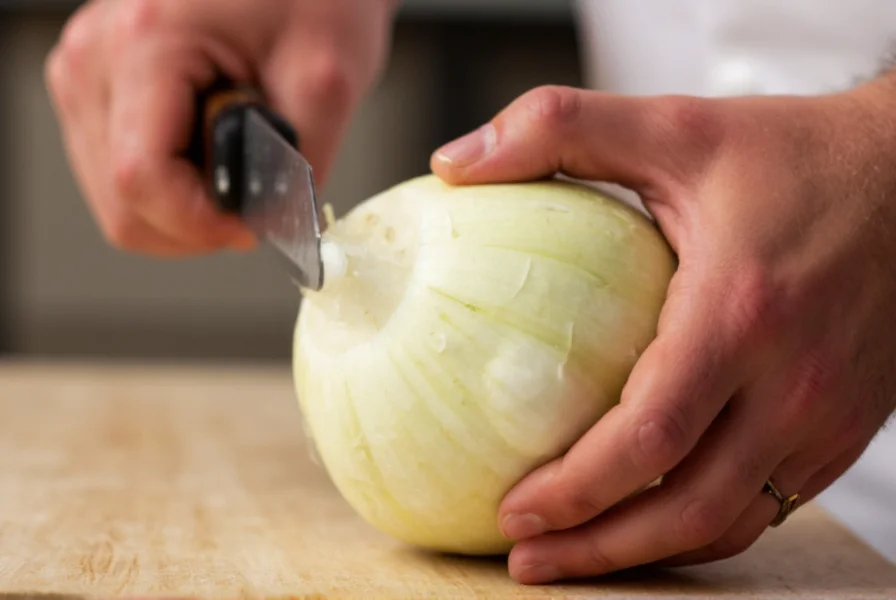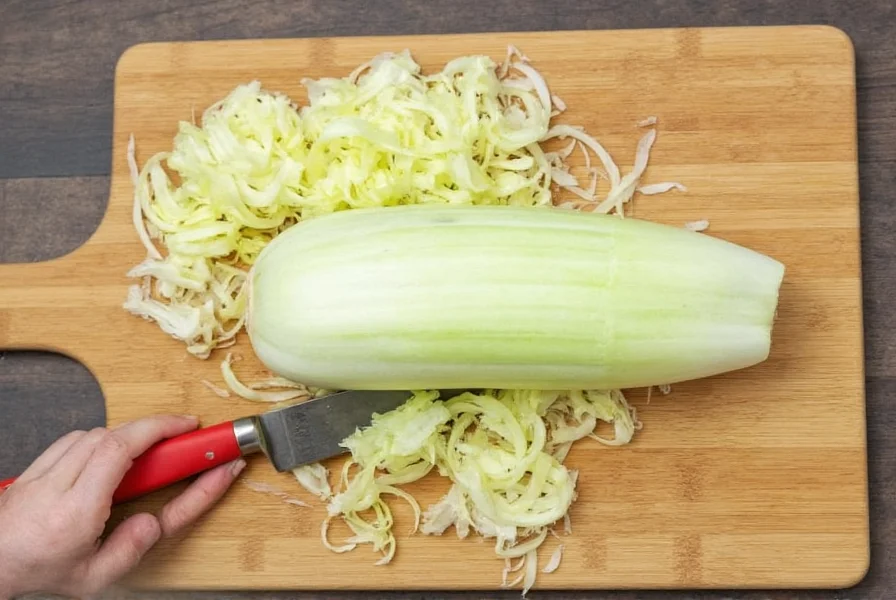Cutting fennel might seem intimidating at first glance, but with the right technique, you'll transform this anise-flavored vegetable into perfectly prepared ingredients for salads, roasts, or soups. This comprehensive guide walks you through every step of fennel preparation with professional kitchen insights you won't find elsewhere.
Understanding Fennel Anatomy
Fennel consists of three main parts: the bulb (the white, layered base), the stalks (long, celery-like stems), and the feathery fronds (delicate green tops). Each part is edible and offers unique culinary applications. The bulb contains the most pronounced anise flavor and requires proper cutting technique to maximize usability and minimize waste.
Essential Tools for Cutting Fennel
Before you begin, gather these kitchen essentials:
- Sharp chef's knife (8-10 inches)
- Cutting board (preferably wood or plastic)
- Vegetable peeler (optional for tough outer layers)
- Bowl for collecting fronds

Step-by-Step Fennel Cutting Guide
Follow these professional kitchen techniques for perfect fennel preparation every time:
- Prepare your workspace: Place your cutting board on a stable surface and have a damp cloth underneath to prevent slipping.
- Trim the stalks: Cut 1-2 inches above the bulb where the stalks meet the bulb. Save the stalks for stocks or braises.
- Remove the fronds: Cut the feathery green tops about 1 inch above the bulb. Store in an airtight container for garnishes or fennel tea.
- Peel if necessary: If outer layers appear dry or tough, use a vegetable peeler to remove just the damaged portions.
- Cut in half lengthwise: Place the bulb flat-side down and cut vertically through the core. This preserves the bulb's structure.
- Core removal (optional): For salads or raw applications, cut a V-shaped wedge around the tough core. For cooked dishes, the core can often remain.
- Slice or dice: Place cut halves flat-side down and proceed with your desired cut.
Mastering Different Fennel Cutting Techniques
Adapt your fennel cutting technique based on your recipe requirements:
| Cutting Style | Best For | Technique Tips |
|---|---|---|
| Thin Slices | Salads, carpaccio | Cut crosswise at 1/8-inch intervals; soak in ice water for 10 minutes to curl |
| Dice (1/4-inch) | Sauces, braises | Cut planks first, then matchsticks, then cubes; keep pieces uniform |
| Julienne | Stir-fries, garnishes | Cut lengthwise into thin planks, then stack and slice lengthwise |
| Wedges | Roasting, grilling | Cut into 6-8 equal wedges through the core for stability |
Professional Tips for Cutting Fennel Without Waste
Reduce food waste while maximizing your fennel yield with these chef-approved techniques:
- Preserve the core: For roasted fennel, keep the core intact to hold wedges together during cooking
- Use the "water method": Submerge cut fennel in acidulated water (water with lemon juice) to prevent browning
- Maximize frond usage: Chop fronds finely for garnish or blend into pesto
- Stalk utilization: Chop stalks for mirepoix or simmer in fish stock
- Perfect slicing angle: Angle your knife slightly when slicing for more surface area in salads
Common Fennel Cutting Mistakes to Avoid
Even experienced home cooks make these fennel preparation errors:
- Cutting against the grain: Always cut fennel lengthwise through the core first to maintain structure
- Discarding usable parts: Over 70% of fennel is edible—don't waste stalks and fronds
- Using a dull knife: A sharp blade prevents bruising and ensures clean cuts
- Removing the core unnecessarily: The core adds structural integrity for roasting
- Improper storage: Cut fennel should be stored in airtight containers with damp paper towels
Storing Cut Fennel Properly
Maximize freshness of your prepared fennel with these storage techniques:
- Store cut fennel in airtight containers with slightly damp paper towels
- Place in the high-humidity drawer of your refrigerator
- Consume within 3-4 days for best quality
- For longer storage, blanch slices for 2 minutes and freeze
- Never store cut fennel near ethylene-producing fruits like apples or bananas
Putting Your Fennel Cutting Skills to Work
Now that you've mastered fennel preparation, try these applications:
- Raw: Thinly sliced fennel makes an excellent base for citrus salads
- Cooked: Wedges roasted with olive oil caramelize beautifully
- Infused: Simmer fronds in cream for unique pasta sauces
- Pickled: Quick-pickled fennel adds brightness to sandwiches
Frequently Asked Questions
Can you eat the entire fennel bulb, including the core?
Yes, the entire fennel bulb is edible. The core becomes tender when cooked, but for raw applications like salads, many chefs prefer removing it as it can be tough. When roasting or braising, keeping the core intact helps maintain the bulb's structure during cooking.
How thin should fennel be sliced for a salad?
For salads, slice fennel between 1/8 to 1/4 inch thick. Thinner slices work well for delicate salads and will naturally curl when soaked in ice water for 10 minutes. If using a mandoline, set it to 1.5mm for perfect salad-ready slices that maintain texture without overwhelming other ingredients.
Why does my cut fennel turn brown so quickly?
Fennel contains enzymes that cause browning when exposed to air, similar to apples. To prevent this, store cut fennel in acidulated water (1 tablespoon lemon juice per cup of water) or in an airtight container with damp paper towels. Properly stored, cut fennel maintains freshness for 3-4 days in the refrigerator.
What's the best knife for cutting fennel?
A sharp 8-10 inch chef's knife works best for cutting fennel. The length provides enough leverage for the dense bulb, while a sharp edge ensures clean cuts without crushing the delicate layers. Avoid serrated knives as they tear rather than slice through fennel. Professional chefs recommend carbon steel or high-carbon stainless steel blades that maintain sharpness through multiple fennel preparations.
How do you prevent fennel from sticking to the knife?
Fennel's high water content can cause sticking. To prevent this, lightly oil your knife blade with a neutral oil before cutting, or run the blade under cold water between cuts. Another professional technique is to tap the knife handle gently after each cut to release the fennel slice. For continuous slicing, a very sharp knife creates less surface tension and reduces sticking.











 浙公网安备
33010002000092号
浙公网安备
33010002000092号 浙B2-20120091-4
浙B2-20120091-4